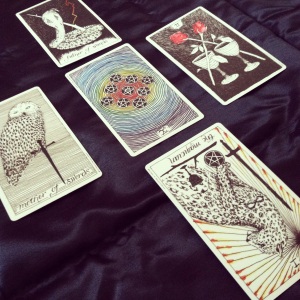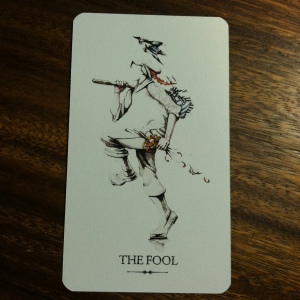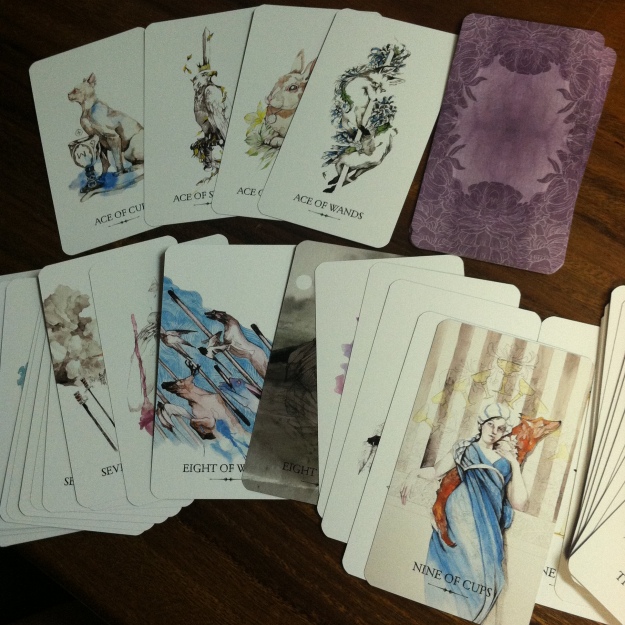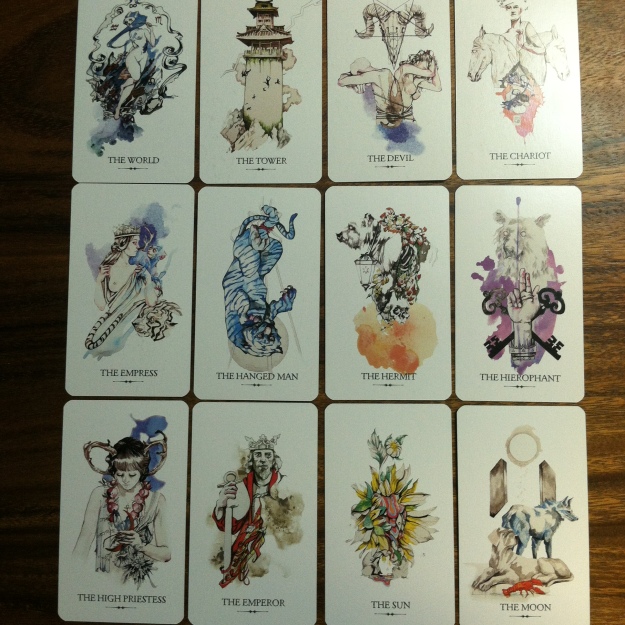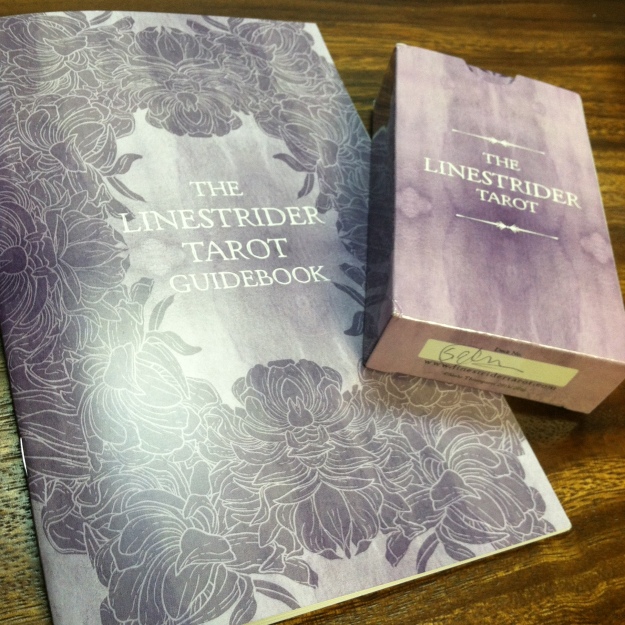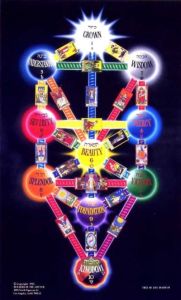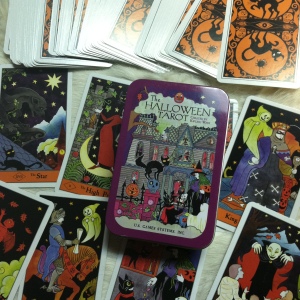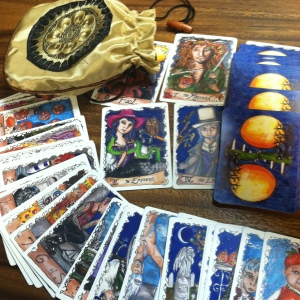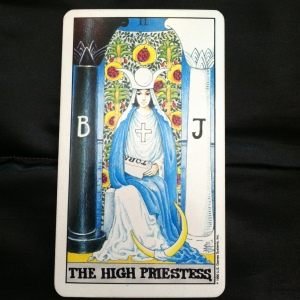 I signed up for the Tarot School Correspondence Course in May of 2012. I’d been flirting with the idea for several months. I picked up my first pack of tarot cards back when I was thirteen (I’m in my thirties now) and had taught myself to use them by reading books and practicing on friends. I was well-read, but not particularly experienced, and definitely not confident.
I signed up for the Tarot School Correspondence Course in May of 2012. I’d been flirting with the idea for several months. I picked up my first pack of tarot cards back when I was thirteen (I’m in my thirties now) and had taught myself to use them by reading books and practicing on friends. I was well-read, but not particularly experienced, and definitely not confident.
My professional life is in academia and teaching, so I’m a big fan of organized learning. I need a lot of structure, whether I’m creating it for myself or working though someone else’s. I was interested in applying some of the same formalities to my own studies of tarot: set reading materials, homework, practice activities, and feedback from an expert I respected and trusted.
There are a lot of tarot courses available online and through correspondence (nevermind the countless books that provide all kinds of curriculae, to the point of being overwhelming). I don’t remember exactly how I found Tarot School; I think it was while researching tarot certification programs. The Amberstones have a couple of published books, a number of shorter audio courses available online, in-person workshops in New York City, and, of course, they’re responsible for the Readers Studio. Their reputation precedes them, so I felt pretty comfortable committing to this course (and chose it over others because of the promised one-on-one attention).
Just to be sure, I purchased one of the audio courses (as a bonus, it was on sale already in recognition of World Tarot Day, and I even had a coupon from signing up for the Tarot Tips newsletter). Over the course of a couple of weeks, I listened to these recordings, taking detailed notes and repeatedly having my mind blown just by listening to the ensuing discussions (the audio courses are recordings of live classes, so you get the added benefit of other students’ questions and commentary, with the Amberstones’ unfiltered responses). I was hooked. I knew that the full Correspondence Course would be worthwhile.
The Cost
The Correspondence Course isn’t cheap; there’s no two-ways about it. You have the option of paying for just the materials and working without outside guidance, which is only a fraction of the price of the full course (and significantly less appealing, in my mind, for reasons I’ll get to). You can also pay a little bit more than the full cost and submit your work via e-mail, which can save time, paper, and the hassle of dealing with the postal system.
I reasoned that it wasn’t any more expensive than one of my university classes (I was in graduate school at the time), and would likely be a good investment if I could turn my work into a professional tarot business. I was also allowed to pay in monthly installments, so the overall cost was bearable. There are courses offered for half the cost elsewhere (even some that offer “certification”), but I haven’t seen one that offers nearly the information, experience, or feedback offered at Tarot School.
But the real benefit of this course is the one-on-one time with Wald Amberstone, and that’s what I feel like I’m paying for. In my household, we joke that it’s a little like calling Yoda and talking about the Force (“EVERYBODY SHUT AND STOP BOTHERING ME UP IT’S TIME TO CALL WALD AND ABSORB WISDOM”). Wald’s experience in tarot is practically unparalleled, and his work has led him to be informed in a number of related subjects. My thinking tends to be abstract and often wanders into other occult subjects, and he has never failed to challenge me. Not once has he spouted self-help platitudes at me, for which I couldn’t be more grateful. He’s totally unpretentious, and always willing to say “I don’t know” if that’s what the question calls for. Our conversations last anywhere from forty minutes to a bit over an hour, and I look forward to them immensely. He doesn’t critique my work, per se, but rather draws connections and observes patterns that escape me on my own. If I had questions in my writing, he answers them. Mostly, he energizes my work, not just in tarot, but also as an occultist in the Western tradition. My conversations with Wald have even impacted my thinking as a Gardnerian witch, which I think is saying something.
The Time
On Tarot School’s website, we’re told to allow about three years to finish the whole course and earn the degree. I’ve never had conversations with other Correspondence Course students, so I can’t speak to the accuracy of this figure, but I’m moving at a much slower rate than that. Between my assorted jobs, writing professionally, running a Wiccan coven, and periodically entertaining the fantasy of a social life, it takes me about five months to finish a correspondence course lesson.
To be fair, I’m also a bit of a freak when it comes to these assignments. The minimum number of pages for each activity (and there might be 20-40 activities that require a writing component in each lesson) is one, with a max of five. The completed lessons I turn in are generally about 50 to 75 pages of original writing. Even if you stick to the minimum, you will have written the equivalent of a ginormous book by the time you’ve finished this course. It’s a lot of work, it requires a lot of time, and I don’t doubt that many people simply aren’t inclined to put in that much effort. Even if you only do the bare minimum, you’re still producing something enormous and profound. You have to be self-motivated.
You can do it all at your own pace, though. If you’re disciplined and patient with yourself, it’s doable. Wald is a phone call away (and always enthused and encouraging…I even butt-dialed him once), and there are outside resources listed throughout the course that can be helpful. If you’re a correspondence course junkie, I’d recommend toning it down and just focusing on this one, just for the sake of time. There’s a lot to be had here, particularly if you give it your full attention.
The Result
Since beginning work on the Tarot School Correspondence Course, I’ve become a professional reader. I have a website, a blog, and a practice out of a local storefront. I don’t make my living at tarot, but I have made enough money to cover the cost of the course several times over.
I have a handle on some of the most commonly avoided tarot-related subjects: Qabalah, astrology, and alchemy. You can choose to ignore those things down the road if they’re not your thing, but they’re no longer intimidating or irrelevant to my tarot practice. I’m excited about them now.
I have my own gigantic body of original writing (whether it’s journaling or more formal essays about particular cards or concepts) upon which to draw when I get stuck or just need to be inspired. I also have a strong enough foundation in a variety of tarot-related subjects, so it’s easier to recognize good sources when I’m looking to expand into some other tarot realm.
I’ve got a mentor I trust.
I’ve developed the confidence to reach out to other tarot communities (through Tarot School, locally, and through other online sources), making new friends, learning tons of things it had never even occurred to me to know.
And I’m barely halfway through the course, three years later. So ask me again in another three years!
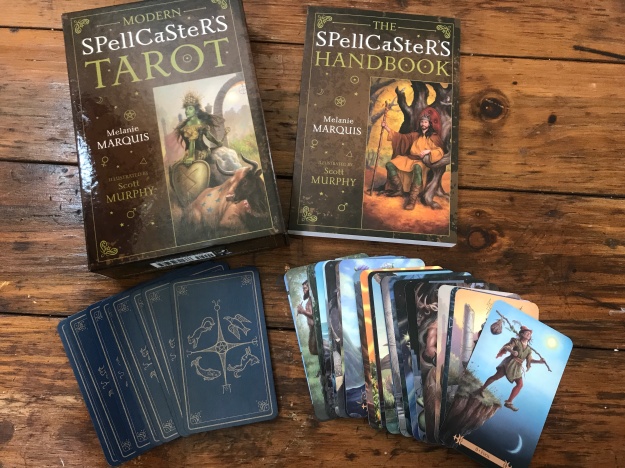 I received the Modern Spellcaster’s Tarot by Melanie Marquis and Scott Murphy way back in February. I’ve only just now opened them. Why the wait? Partially, it’s because they were a freebee from my publisher, along with a bunch of awesome books (at conferences, it’s often more cost effective for publishing houses to send sample copies home with attendees than it is to ship or fly materials back to some warehouse, hence my pile of booty), so I didn’t have the same kind of investment I normally would if I’d actually used my own money to purchase them. Further, I’m just not usually very impressed by mass published decks. There are absolutely some gems out there, but they tend to look the same to me after a while.
I received the Modern Spellcaster’s Tarot by Melanie Marquis and Scott Murphy way back in February. I’ve only just now opened them. Why the wait? Partially, it’s because they were a freebee from my publisher, along with a bunch of awesome books (at conferences, it’s often more cost effective for publishing houses to send sample copies home with attendees than it is to ship or fly materials back to some warehouse, hence my pile of booty), so I didn’t have the same kind of investment I normally would if I’d actually used my own money to purchase them. Further, I’m just not usually very impressed by mass published decks. There are absolutely some gems out there, but they tend to look the same to me after a while.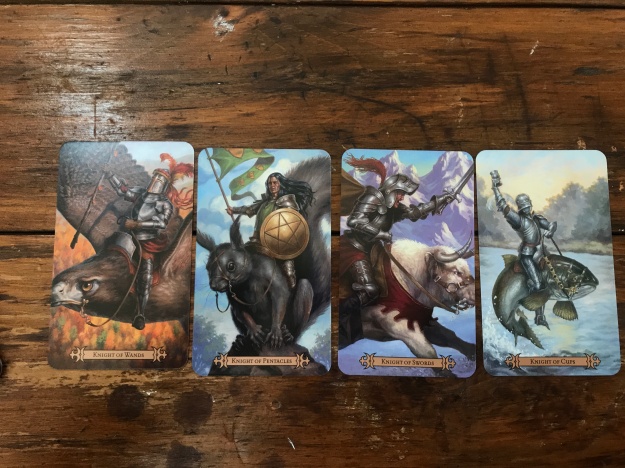 The Knights are some of my favorite cards, and I love what’s happening with their mounts. The Knight of Cups—on his bigass fish—is easily the most delightful tarot image I’ve seen all year. These guys are just such…dudes. Take away their horses and give them giant squirrels and suddenly they’re a thousand times more relatable (in my world, oversized forest beasts = relatable).
The Knights are some of my favorite cards, and I love what’s happening with their mounts. The Knight of Cups—on his bigass fish—is easily the most delightful tarot image I’ve seen all year. These guys are just such…dudes. Take away their horses and give them giant squirrels and suddenly they’re a thousand times more relatable (in my world, oversized forest beasts = relatable).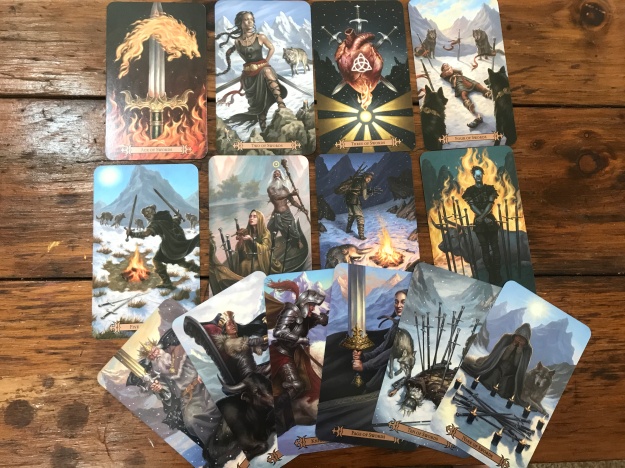
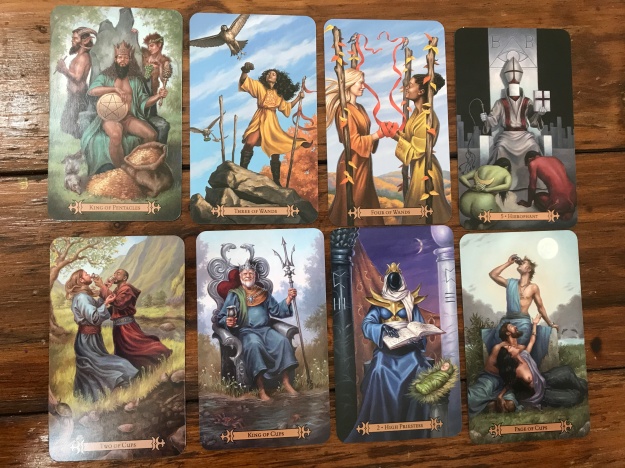
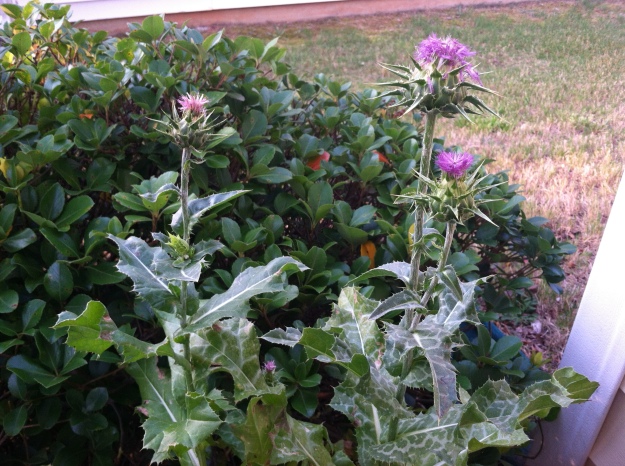 Have you ever signed up for something and then not finished? Or maybe just haven’t been able to work at the rate you’d prefer?
Have you ever signed up for something and then not finished? Or maybe just haven’t been able to work at the rate you’d prefer?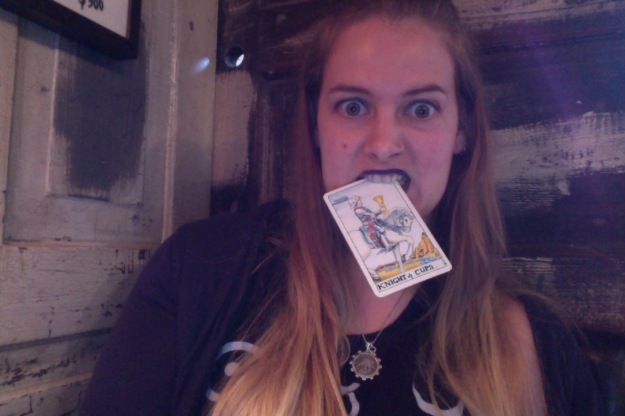 Okay. First, I need to put on my religious studies scholar hat.
Okay. First, I need to put on my religious studies scholar hat.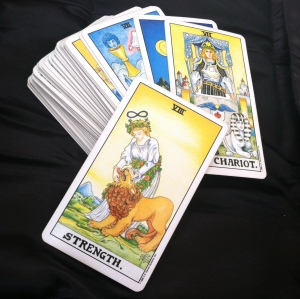 All of the trumps are complex cards. There are so many stories we could tell, and so many systems of esoteric knowledge that we could draw upon for interpretation. There’s really no way to know everything about any one card—the connections are infinite and highly individual, and we build them as we work with the cards. Strength, though, is one of those cards that I think a lot of people feel like they have a handle on. It’s easy for a novice reader to draw this card and conclude, simply, that a querent should “use a different kind of strength” or some such. She wouldn’t be wrong, of course. But, as in all things tarot related, there’s a lot more going on.
All of the trumps are complex cards. There are so many stories we could tell, and so many systems of esoteric knowledge that we could draw upon for interpretation. There’s really no way to know everything about any one card—the connections are infinite and highly individual, and we build them as we work with the cards. Strength, though, is one of those cards that I think a lot of people feel like they have a handle on. It’s easy for a novice reader to draw this card and conclude, simply, that a querent should “use a different kind of strength” or some such. She wouldn’t be wrong, of course. But, as in all things tarot related, there’s a lot more going on.
